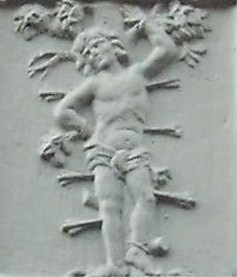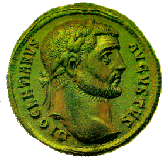
 Gaius Aurelius Valerius Diocletanius (c 243-316) is the Latinized name
of an ordinary soldier with a Greek name - Diokles -
born in the nearest vicinity of the then capital of the
Roman province of Dalmatia Salona.
Gaius Aurelius Valerius Diocletanius (c 243-316) is the Latinized name
of an ordinary soldier with a Greek name - Diokles -
born in the nearest vicinity of the then capital of the
Roman province of Dalmatia Salona.
He was pronounced emperor on November 20, 284 AD. In order to restore order in Gaul and to prevent usurpation of the throne, he named his friend Maximian as co-regent and placed the western part of the empire under his rule. In 293, the two of them took as co-regents Galerius, married to Diocletian's daughter Valeria and Constanline Chlorus.
Diocletian continued to govern directly the Asiatic part of the empire and Egypt from the capital of Nicomedia. He made of the empire an absolutist monarchy on the Persian model. He secured the state borders implemented a new territorial partition of the empire separated military from civilian administration, reconstructing the inner organisation of the army and state bureaucracy, and put in order the financial monetary and tax systems. He ordained that estates be hereditary, binding people in this way to their properties and cities. Diocletian passed a decree limiting prices. He took away from the Senate their former rights. Rome was no longer the capital. Although initially tolerant of Christianity, in 303 he issued an edict in Nicomediam in which he prohibited it. This brought about numerous executions, the confiscation of property, and the destruction of churches. On May 1, 305 he abdicated (persuading Maximian to do likewise), and retired to the palace he had prepared for his retirement. His biographer, Lactantius, a writer of little talent and even less honour, describes Diocletian's "implacable passion to build", without mentioning his Split palace nor the monumental baths he had built in Rome, which he had visited probably only once.
During the half century before his appearance there were no less than twenty emperors
proclaimed by the Senate and at least as many usurpers and pretenders. Diocletian's seemingly
fortuitous rise to power was not a mere episode but he succeeded to rule for two decades and
lived to see a long retirement after abdicating, which amounts almost to a miracle. It can be stated
that it was thanks to him that the Empire at least in the East, was rescued. The faces of Diocletian
and his wife Prisca can be made out on the busts in the medallions of the frieze inside the
Mausoleum (today's Cathedral).
Page last modified December, 1996.
Thanks to http://www.st.carnet.hr/split/car.html